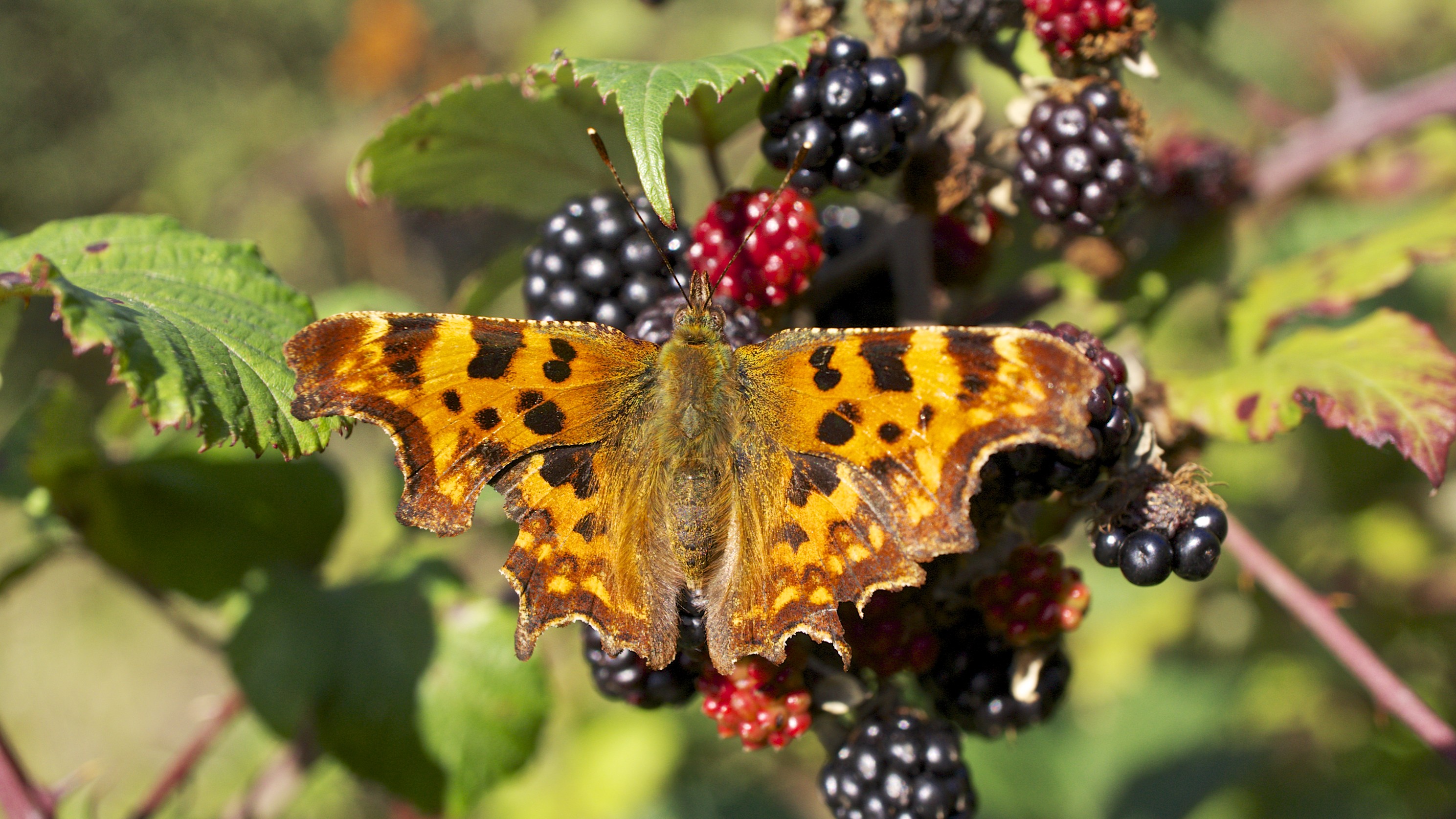Over 40 species of butterflies visit Owl Acres at various times throughout the year. Their flashes of color and elegant shapes brighten the landscape throughout the spring, summer and fall. Many are nectar-eaters, drawn to flowers throughout the warmer months. And some, like the comma butterfly (Polygonia c-album), fill a different type of niche in the landscape.
These butterflies don’t have the classic smooth wing shape we associate with monarchs. Instead, they belong to a group of butterflies called anglewings. The edges of their wings look ragged with points and curves and angles. When the wings are spread to their full two to two and a half inches, the edges resemble curly brackets.
Comma butterflies don’t migrate. They live here year-round. They have two distinct forms—summer and winter. The summer form has orange forewings with black accents, and black hindwings with orange accents. The winter form is mostly orange. This time of year in the fall, as the weather gets colder, the paler winter brood which hatched in late summer starts looking for places to overwinter. They’ll hide under tree bark, in cracks in the rock, holes in trees and similar sheltered places. These winter butterflies don’t freeze because they have glycerol in their blood that acts as an antifreeze. So they can just shut down for the winter and wake up in the spring. You might see them on warm and sunny winter days awake and flying around, wondering if it’s time to get up yet. When the evening gets cold again, they go back to their winter shelter.
When they wake up for real, they will start feeding, mating, and laying eggs. This is where the hops come in. The comma butterflies lay their eggs on the leaves of elm, hackberry, nettle and hops plants. These tiny, barrel-shaped eggs hatch into tiny caterpillars. The caterpillars are a mix of white, green, and black stripes and dots. They have several rows of pale, branched spines. The caterpillars start feeding on the leaves of their host plants at night and hide underneath the leaves during the day. After about four weeks, the caterpillars have grown much bigger and are ready for the next phase of their lives. They form a chrysalis. This chrysalis is a hard outer skeleton. Inside this protective covering, the caterpillar will pupate, changing into an adult butterfly. The chrysalis is brown with two rows of spikes on the abdomen. An old saying attributed to hops farmers is that if the spikes are gold, the price of hops will be high, and if they’re silver, it will be low. That’s probably the reason the butterflies are nicknamed hop merchants.

This one is too good not to share. Green, barrel-shaped egg of a comma butterfly sits on the tip of a nettle leaf amid a forest of the plant’s stinging hairs. The egg has long-wise ridges that look like glass, ala Faberge. The House of Romanov would be proud of this jewel. Photo from Wikimedia.org by: Gilles San Martin
When the adults of the summer brood emerge from their chrysalises in May, they are dressed in their summer finery. The hindwings are almost all black, and the forewings are orange with black spots and borders. The underside of the wings is a rippley brown and white, and at the center of each hindwing is a white comma-shaped spot that gives it the name comma butterfly. Its coloring and the shape of its wings when folded provide it with an excellent camouflage. It looks a lot like dried leaves, or bird droppings when it hangs upside down.

Comma butterfly rests on a thistle flower. With wings folded, it looks like a dry leaf. The ragged shape of the wing’s trailing edge is easy to see. Look for the white “comma” mark on the hind wing. Photo from Wikimedia.org by: Smudge 9000
The comma butterfly isn’t a nectar feeder. Instead, it is a generalist feeder, preferring rotting fruit, animal droppings, sap, and the salts and minerals in puddles. They will eat nectar as a last resort.
These little fellows, with wingspans up to two inches are erratic and aggressive flyers. The males are very territorial and have been known to chase birds. They also fight with each other to defend territory and end up with their wings looking more ragged than ever.
Up to three broods of comma butterflies can occur in one year, hatching in May, July and September. The September brood will complete the cycle by overwintering as adults.
A close relative of the comma butterfly is the question mark butterfly (Polygonia interrogationis. Fabricius). In most respects, including lifecycle, markings and habitat, they are similar to their close cousins. They are differentiated from the commas by the question marks, (a curved line with a dot) on the undersides of their hindwings.
With its hops, elm, hackberry and nettles, Owl Acres has plenty of habitat for both comma and question mark butterflies. So we’ll see flashes of orange most of the year and wonder, which punctuation do we use here? a comma, or a question mark?
Feature photo from Wikimedia.org by: Ian Kirk Alt text: Comma butterfly sits on a bunch of summer berries. Orange wings with black marks and the angular/scalloped rear edges of both pairs of wings that give these animals the name “anglewings.”
